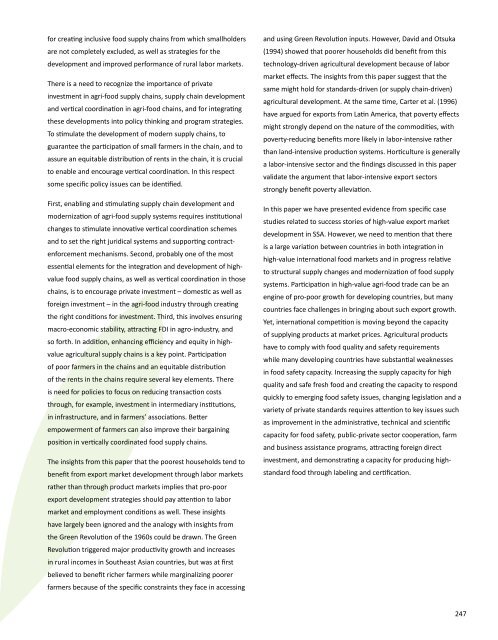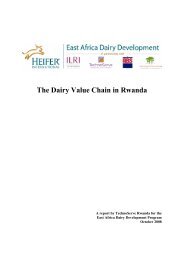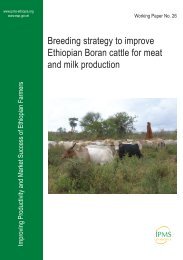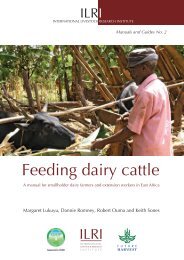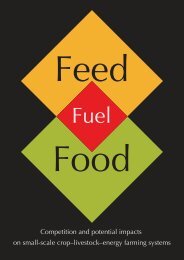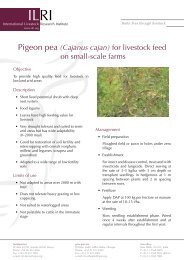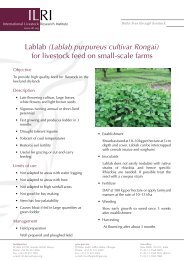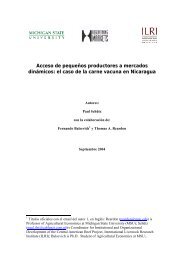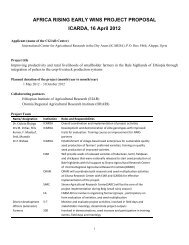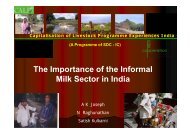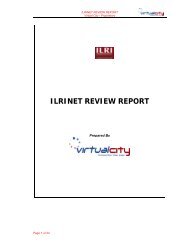High-Value Commodities and Agroprocessing - International ...
High-Value Commodities and Agroprocessing - International ...
High-Value Commodities and Agroprocessing - International ...
Create successful ePaper yourself
Turn your PDF publications into a flip-book with our unique Google optimized e-Paper software.
for creating inclusive food supply chains from which smallholders<br />
are not completely excluded, as well as strategies for the<br />
development <strong>and</strong> improved performance of rural labor markets.<br />
There is a need to recognize the importance of private<br />
investment in agri-food supply chains, supply chain development<br />
<strong>and</strong> vertical coordination in agri-food chains, <strong>and</strong> for integrating<br />
these developments into policy thinking <strong>and</strong> program strategies.<br />
To stimulate the development of modern supply chains, to<br />
guarantee the participation of small farmers in the chain, <strong>and</strong> to<br />
assure an equitable distribution of rents in the chain, it is crucial<br />
to enable <strong>and</strong> encourage vertical coordination. In this respect<br />
some specific policy issues can be identified.<br />
First, enabling <strong>and</strong> stimulating supply chain development <strong>and</strong><br />
modernization of agri-food supply systems requires institutional<br />
changes to stimulate innovative vertical coordination schemes<br />
<strong>and</strong> to set the right juridical systems <strong>and</strong> supporting contractenforcement<br />
mechanisms. Second, probably one of the most<br />
essential elements for the integration <strong>and</strong> development of highvalue<br />
food supply chains, as well as vertical coordination in those<br />
chains, is to encourage private investment – domestic as well as<br />
foreign investment – in the agri-food industry through creating<br />
the right conditions for investment. Third, this involves ensuring<br />
macro-economic stability, attracting FDI in agro-industry, <strong>and</strong><br />
so forth. In addition, enhancing efficiency <strong>and</strong> equity in highvalue<br />
agricultural supply chains is a key point. Participation<br />
of poor farmers in the chains <strong>and</strong> an equitable distribution<br />
of the rents in the chains require several key elements. There<br />
is need for policies to focus on reducing transaction costs<br />
through, for example, investment in intermediary institutions,<br />
in infrastructure, <strong>and</strong> in farmers’ associations. Better<br />
empowerment of farmers can also improve their bargaining<br />
position in vertically coordinated food supply chains.<br />
The insights from this paper that the poorest households tend to<br />
benefit from export market development through labor markets<br />
rather than through product markets implies that pro-poor<br />
export development strategies should pay attention to labor<br />
market <strong>and</strong> employment conditions as well. These insights<br />
have largely been ignored <strong>and</strong> the analogy with insights from<br />
the Green Revolution of the 1960s could be drawn. The Green<br />
Revolution triggered major productivity growth <strong>and</strong> increases<br />
in rural incomes in Southeast Asian countries, but was at first<br />
believed to benefit richer farmers while marginalizing poorer<br />
farmers because of the specific constraints they face in accessing<br />
<strong>and</strong> using Green Revolution inputs. However, David <strong>and</strong> Otsuka<br />
(1994) showed that poorer households did benefit from this<br />
technology-driven agricultural development because of labor<br />
market effects. The insights from this paper suggest that the<br />
same might hold for st<strong>and</strong>ards-driven (or supply chain-driven)<br />
agricultural development. At the same time, Carter et al. (1996)<br />
have argued for exports from Latin America, that poverty effects<br />
might strongly depend on the nature of the commodities, with<br />
poverty-reducing benefits more likely in labor-intensive rather<br />
than l<strong>and</strong>-intensive production systems. Horticulture is generally<br />
a labor-intensive sector <strong>and</strong> the findings discussed in this paper<br />
validate the argument that labor-intensive export sectors<br />
strongly benefit poverty alleviation.<br />
In this paper we have presented evidence from specific case<br />
studies related to success stories of high-value export market<br />
development in SSA. However, we need to mention that there<br />
is a large variation between countries in both integration in<br />
high-value international food markets <strong>and</strong> in progress relative<br />
to structural supply changes <strong>and</strong> modernization of food supply<br />
systems. Participation in high-value agri-food trade can be an<br />
engine of pro-poor growth for developing countries, but many<br />
countries face challenges in bringing about such export growth.<br />
Yet, international competition is moving beyond the capacity<br />
of supplying products at market prices. Agricultural products<br />
have to comply with food quality <strong>and</strong> safety requirements<br />
while many developing countries have substantial weaknesses<br />
in food safety capacity. Increasing the supply capacity for high<br />
quality <strong>and</strong> safe fresh food <strong>and</strong> creating the capacity to respond<br />
quickly to emerging food safety issues, changing legislation <strong>and</strong> a<br />
variety of private st<strong>and</strong>ards requires attention to key issues such<br />
as improvement in the administrative, technical <strong>and</strong> scientific<br />
capacity for food safety, public-private sector cooperation, farm<br />
<strong>and</strong> business assistance programs, attracting foreign direct<br />
investment, <strong>and</strong> demonstrating a capacity for producing highst<strong>and</strong>ard<br />
food through labeling <strong>and</strong> certification.<br />
247


